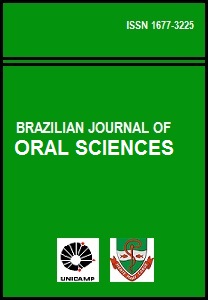Abstract
The aim of this study was to evaluate the effect of different photoactivation methods and base materials on the stress generated by the polymerization shrinkage of composites. The evaluated groups for the base material were: (G1) 1 coat of adhesive; (G2) 3 coats of adhesive, and (G3) flowable composite as a liner. The groups were divided in agreement with the photoactivation method: Continuous light (CL); Stepped Light (SL); Intermittent Light (IL); LED and Xenon Plasma Arc (XP). The generated stress was measured in a universal testing machine 5 minutes after the end of the photoactivation. The results were submitted to ANOVA and the averages values compared by Tukey test (5%). Inside of G1 group the mean values varied between 1.62 MPa (XP) to 2.22 MPa (CL), in which the XP method presented statistically inferior values to the other appraised methods. The values inside of G2 and G3 varied from 1.64 MPa (LED) to 2.15 MPa (CL) and 1.24 MPa (IL) to 1.92 MPa (SL), respectively, and the methods LED and IL presented statistically inferior values comparatively to the method CL inside of G2 and CL and SL inside of G3. The use of base materials was shown efficient in the reduction of the stress level generated by the polymerization shrinkage of restorative composites when LED or Intermittent light photoactivation methods are used.References
Cunha LG, Sinhoreti MAC, Consani S, Sobrinho LC. Effect of different photoactivation methods on the polymerization depth of a light-activated composite. Oper Dent 2003; 28: 155-9.
Unterbrink GL, Liebenberg WH. Flowable composites as “filled adhesives”: Literature review and clinical recommendations. Quintessence Int 1999; 30: 249-57.
Silikas N, Eliades G, Watts DC. Light intensity effects on resincomposite degree of conversion and shrinkage strain. Dent Mater 2000; 16: 292-6.
Koran P, Kürschner R. Effect of sequential versus continuous irradiation of a light-cured resin composite on shrinkage, viscosity, adhesion, and degree of polymerization. Am J Dent 1998; 11: 17-22.
Uno S, Asmussen E. Marginal adaptation of restorative resin polymerized at reduced rate Scan J Dent Res 1991; 99: 440-4.
Obici AC, Sinhoreti MAC, de Goes MF, Consani S, Correr Sobrinho L. Effect of the photo-activation method on polymerization shrinkage of restorative composites. Oper Dent 2002; 27: 192-8.
Ikemi T, Nemoto K. Effects of lining materials on the composite resins shrinkage stresses. Dent Mater J 1994; 13: 1-8.
Davidson CL, Feilzer AJ. Polymerization shrinkage and polymerization shrinkage stress in polymer-based restoratives. J Dent 1997; 25: 435-40.
Feilzer AJ, Doren LH, de Gee AJ, Davidson CL. Influence of light intensity on polymerization shrinkage and integrity of restoration-cavity interface. Eur J Oral Sci 1995; 103: 322-6.
Peutzfeldt A. Resin composites in dentistry: the monomer system. Eur J Oral Sci 1997; 105: 97-116.
Feilzer AJ, de Gee AJ, Davidson CL. Setting stress in composite resin in relation to configuration of the restoration. J Dent Res 1987; 66: 1636-9.
Feilzer AJ, de Gee AJ, Davidson CL. Quantitative determination of stress reduction by flow in composite restorations. Dent Mater 1990; 6: 167-71.
Ernst CP, Kürschner R, Rippin G, Willershausen B. Stress reduction in resin-based composites cured with a two-step lightcuring unit. Am J Dent 2000; 13: 69-72.
Price RB, Rizkalla AS, Hall GC. Effect of stepped light exposure on the volumetric polymerization shrinkage and bulk modulus of dental composites and an unfilled resin. Am J Dent 2000; 13: 176-80.
Davidson-Kaban SS, Davidson CL, Feilzer AJ, de Gee AJ, Erdilek N. The effect of curing light variations on bulk curing and wallto-wall quality of two types and various shades of resin composites. Dent Mater 1997; 13: 344-52.
Sharkey S, Burke F, Ziada H, Hannigan A. Surface hardness of light-activated resin composites cured by two different visiblelight sources: an in vitro study. Quintessence Int 2001; 23: 401-5.
Jandt KD, Mills RW, Blackwell GB, Ashworth SH. Depth of cure and compressive strength of dental composites cured with blue light emitting diodes (LEDs). Dent Mater 2000; 16:41-7.
Stahl F, Ashworth SH, Jandt KD, Mills RW. Light-emitting diode (LED) polymerization of dental composites: flexural properties and polymerization potential. Biomater 2000; 21: 1379-85.
Anusavice KJ. Phillips materiais dentários 10.ed. Rio de Janeiro: Guanabara Koogan; 1998.
The Brazilian Journal of Oral Sciences uses the Creative Commons license (CC), thus preserving the integrity of the articles in an open access environment.

